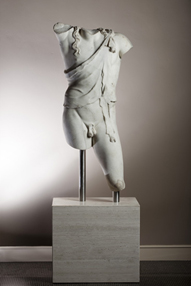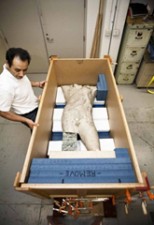
Unknown
Roman
Lansdowne Dionysus, 2nd c. CE, 1st half
marble
53 × 27 1/2 × 13 1/2 in.
SBMA, Museum purchase with the Ludington Deaccessioning Fund
2009.1.1

Bartolomeo Cavaceppi, engraving of Dionysus from multi-volume, illustrated record of the works of art, published in 1768-1772.
POSTSCRIPT
EYE ON CONSERVATION: THE LANSDOWNE DIONYSUS
12 JANUARY 2011
In 2009, as part of the dispersal of Wright Ludington’s (one of SBMA’s founders and patrons) estate at Val Verde, SBMA was able to acquire two significant works of art that were originally part of Ludington’s collection of antiquities; a Roman sarcophagus of the 1st or 2nd century A.D. and a large fragment of a monumental marble statue dating from about 100 -150 A.D. The sarcophagus was in good enough condition to be put on view at the Museum, but the statue had been displayed outdoors and had suffered accordingly. Acquired by Ludington in the same 1930 auction in which he acquired the SBMA’s celebrated Lansdowne Hermes (Roman, first half of 2nd century A.D., currently on view in Ludington Court, the sculpture has been identified through its “attributes” (an animal skin and a chiton, traces of which are discernible on the piece) as a representation of Dionysus, the God of Wine. The sculpture is being conserved by Elizabeth (“Liz”) Chayes of the Getty Villa. We expect to put it on view, along with the sarcophagus, sometime next year.
Below is an interview between Eik Kahng, SBMA Chief Curator, and Liz Chayes:
Eik Kahng: Can you tell us a little about where the conservation work will be carried out? Will you be working with anyone else on the project?
Liz Chayes: It is a privilege to be the conservator on this project, which is a collaboration between The J. Paul Getty Museum and The Santa Barbara Museum of Art. The work will be carried out at the Antiquities Conservation Department, located at the Getty Villa in Malibu, California.
EK: Can you tell us about your prior experience as an antiquities conservator?
LC: I am a graduate of the UCLA/Getty Conservation Program, which is a three-year graduate program that focuses on the conservation of ethnographic and archaeological materials. Through the program, I gained conservation experience in museums and archaeological sites around the world, including Africa, England and Australia. Prior to graduate school, I worked in museums, archives and archaeological sites within Southern California for eight years.
EK: The Dionysus was displayed outdoors in Wright Ludington’s garden for many years. What special challenges does this pose in terms of conservation?
LC: There are many challenges in conserving stone sculpture that has been exposed to an uncontrolled, outdoor environment. Aside from temperature fluctuations, dirt accumulation and moisture, there are microorganisms, algae and lichen that can deteriorate and discolor the stone.
EK: The Dionysus has been restored numerous times in the past, sometimes almost beyond recognition; for example, it was ‘completed’ in the 18th century by the famous Roman sculptor/ ‘conservator’, Bartolomeo Cavaceppi (probably born 1716, d. 1799) as seen in this engraving (below) from Cavaceppi’s multi-volume, illustrated record of the works of art he restored and collected, published in 1768-1772). How has the practice of restoration/conservation evolved over the years, and where does it stand now?
LC: Ancient sculptures have often been subjected to multiple campaigns of restoration and alterations throughout their history, using irreversible materials and techniques. Today, conservation has evolved by focusing on strategies to improve structural integrity while using reversible materials and methods that, if required, can be easily identified and removed in the future.
EK: You can see quite clearly from Cavaceppi’s print of the sculpture as he imaginatively restored it, that he was basing his conjecture on a certain, identifiable iconographical ‘type,’ presumably based on additional fragments of the original that are now lost. Cavaceppi’s improvisations were probably removed some time in the 19th century.
://blog.sbma.net/2011/01/eye-on-conservation-the-lansdowne-dionysus/

Lansdowne Dionysus being prepared to travel to the Getty Villa for conservation.
COMMENTS
Transporting, conserving, and cleaning a 900-pound, over life-size fragment of marble Roman statue dating from around 100–150 CE can be a daunting process―but can also render glorious results. After months of careful planning and conservation assistance from neighboring J. Paul Getty Museum’s Antiquities Conservation Department, the Lansdowne Dionysus is newly-installed in the Santa Barbara Museum of Art’s Ludington Court.
In 2009, the Museum acquired two significant works of art that were originally part of the collection of Wright S. Ludington, one of SBMA’s founders and patrons. The works included a Roman sarcophagus of the 1st or 2nd century CE, and a large fragment of a monumental marble statue dating from about the 2nd century CE. These joined the important group of antiquities that Ludington had given to the Museum years earlier. The sarcophagus was in good enough condition to be put on view, but the statue fragment had been displayed outdoors for many years and had suffered the effects of the environment.
Identified as a representation of Dionysus, the god of wine, the sculpture was conserved by Elizabeth (“Liz”) Chayes at the Getty Villa in Malibu, CA, overseen by Jerry Podany, Senior Conservator of Antiquities at J. Paul Getty Museum.
After a careful and systematic cleaning of the marble, the piece was stabilized to improve its structural integrity, as the original stand it had been mounted on created pressure on the marble and an increased propensity for fracture.
Cheyes also had to contend with the fact that the Lansdowne Dionysus has been restored numerous times in the past, sometimes almost beyond recognition.
The Dionysus sculpture was originally lifted from a bog along with more than 70 individual works of ancient sculpture at Hadrian’s Villa in Tivoli in the mid-18th century, and came into the hands of Bartolomeo Cavaceppi (1716-1799), a sculptor who ran a large workshop in Rome restoring ancient marble sculptures. Cavaceppi’s records show that the torso received a new head, arms, legs, and a support consisting of a tree trunk entwined with grapevines (see illustration) to satisfy the taste of the day for whole statues, rather than archaeological fragments.
The restored Dionysus was then sold to the first Marquis of Lansdowne (1737-1805), a British politician and art collector who amassed a spectacular collection of ancient marble sculpture to decorate his house in London, England.
In 1930, when Lansdowne’s descendants put his sculptures up for auction, the Lansdowne Dionysus was purchased by Wright S. Ludington. The statue was brought to California, the 18th-century restorations were removed, and the remaining ancient torso was installed in the gardens of Ludington’s Val Verde estate in Montecito―until 70 years later, when SBMA was able to acquire it.
Ludington donated hundreds of works to SBMA, ranging from antiquity to the 20th century and including the magnificent Lansdowne Hermes, which has graced the Museum’s Ludington Court since 1998. Now, the prestigious and renewed Lansdowne Dionysus joins its counterpart for the public to admire.
http://blog.sbma.net/2012/01/the-art-of-conservation/
